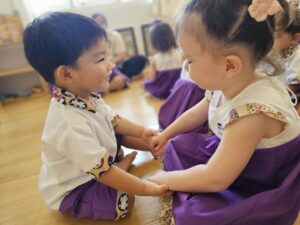Pre-school aged children have natural mathematical minds. They have the capacity to reason, to calculate, and to estimate. They are intensely conscious of quantity – counting skips on the way to school or the steps going up a hill. The concrete Montessori mathematical materials allow these sensorial explorers to begin their mathematical journey from the concrete to abstract through manipulation, experimentation and exploration.
Here are five reasons why we love Montessori Maths!
1. Child-Centric Approach / Individualised Learning
In Montessori, we adopt an individualised learning approach where learning progresses according to each individual child’s pace. Children have the freedom to choose (but of course, within boundaries!) to work on any activity that they would love to do. This makes learning enjoyable. Moreover, with the individualised learning approach, children are not pressured to meet a certain learning benchmark, ensuring that they fully grasp a concept before moving on to another!
2. Concrete Materials
Dr. Maria Montessori believed that children learn by using their senses – whatever they touch, they learn. Children learn Mathematics through tactile experience such as the Sandpaper Numerals where it has a tactile texture. Likewise, rods, spindles and beads are some of the concrete tools used to symbolise mathematical abstractions. The child does not merely learn to count, she understands the concept of ‘how many’ because she holds the amount in her hands.

Learning through the usage of concrete materials create a strong foundation for children. The child is able to perform the operation of addition, subtraction, multiplication, and division in increasing complexity as part of a natural progression.

3. Concrete to Abstract Approach
As the child progresses, she continues to gather from her environment but in a different way. Her inner drive now is to give order to the impressions. She takes the concrete experiences and turns them into more abstract ideas. Her concrete work in the earlier stage literally laid the foundation for complex abstract ideas and thinking.
A prime example of this approach can be seen when the child is working on the Number Rods and Cards. After mastering the Number Rods, the child will be introduced to the Number Cards where she proceeds to match the numerals to the corresponding rods. This one-to-one correspondence allows the child to grasp the value of quantity behind each number.

4. Sensorial Exploration
In a Montessori classroom, Sensorial activities are as vital as numbers and counting. They allow exploration and experimentation on the part of the child and because they are easily explored, they encouraged children to spend a great amount of time in this exploration.
Through working on the many Sensorial activities, children learn several mathematical concepts such as size, length, height, volume, visual discrimination and more! The child develops her mathematical mind through this process of materialised abstraction. The exactness of relationships between the materials makes for the development of a concrete understanding of gradation and order. For instance, the building of Knobless Cylinders requires more than just hand-eye coordination. It involves the child’s ability to be able to identify which cylinder is bigger or smaller.


5. Control of Error
Montessori values independence, confidence and self-reliance. This is one of the reasons why Montessori materials were made to be precise. One of such material is the Spindle Box where children learn to associate numerals (0 to 9) with loose quantities (spindles). There are exactly 45 spindles. When a child is done working with the Spindle Box and should there be any short or leftover, the child will know if something went wrong. At the end of the activity, there should be no spindles left, or any shortages.
These precise-made materials are more than just enhancing the child’s academic abilities. It helps to promote their social-emotional development as well. Children learn independence and self-reliance as they are able to self-correct themselves. This also helps to boost their confidence as they are able to learn independently without the teacher’s intervention.









